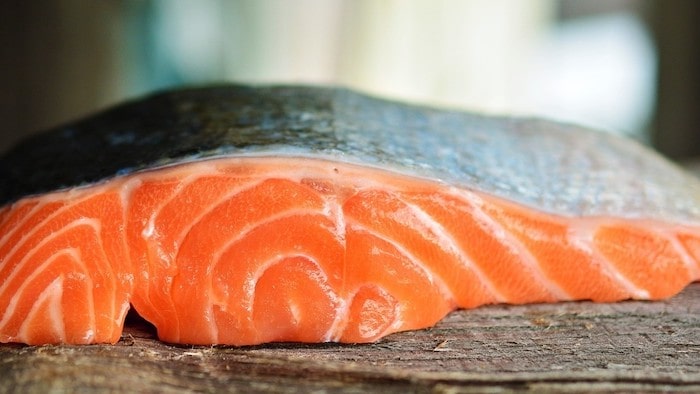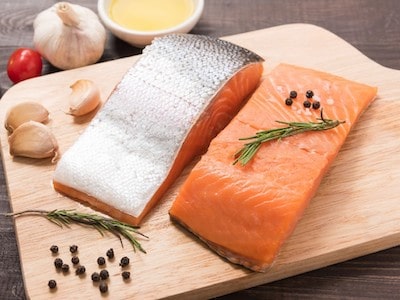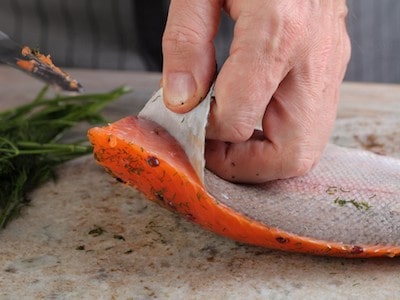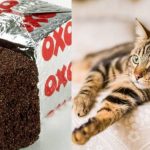As cat owners, we often want to share our favorite foods with our feline friends. However, not all human foods are safe or healthy for cats to consume. One such food that may leave cat owners scratching their heads is salmon skin.

While salmon is a popular and nutritious food for cats, many cat owners are unsure whether or not their pets can eat the skin. In this article, we will explore the question “Can cats eat salmon skin?” and provide you with the information you need to make an informed decision about feeding your cat this popular seafood delicacy.
We’ll discuss the nutritional value of salmon skin, potential risks associated with feeding it to your cat. So, whether you’re curious about feeding your cat salmon skin or just want to learn more about feline nutrition, read on to discover the facts about cats and salmon skin.
Is Salmon Skin Healthy for Cats?
Many pet owners ponder whether it is safe and healthy to feed cats salmon, given the high protein and omega-3 fatty acid content that make it a popular food choice for cats. However, they may also be unsure if the skin should be included.
In general, feeding cats small amounts of salmon skin is unlikely to cause harm and may even have some health benefits. However, there are potential risks associated with feeding cats too much salmon skin or improperly prepared salmon skin. According to hyaenidae “salmon skin also contains a small amount of mercury. While the amount of mercury in salmon skin is not enough to cause health problems in most cats.“
Feeding cats salmon skin can provide numerous benefits, including essential omega-3 fatty acids for healthy skin and fur, as well as potential anti-inflammatory properties that may help reduce joint pain or inflammation.

Additionally, salmon skin is rich in protein, which is important for maintaining strong muscles and a healthy immune system.
Although salmon skin is a good source of nutrition for cats, there are some potential risks associated with it. One major issue is that it contains high levels of fat, which can lead to weight gain and obesity in cats.
Salmon skin may contain high levels of mercury and other toxins, which can accumulate in a cat’s body over time and lead to health issues; thus, it should be avoided.
It’s also important to note that cats may have trouble digesting large amounts of fish or fish skin, which can lead to digestive problems such as vomiting or diarrhea.
Nutritional Value of Salmon Skin
Many people around the world enjoy salmon skin as a popular seafood delicacy. But when it comes to feeding this food to cats, pet owners may be uncertain about its nutritional value and safety for felines.
Salmon skin is an excellent source of protein and omega-3 fatty acids, both necessary to maintain healthy skin, fur, and overall health in cats. These omega-3 fatty acids can reduce inflammation, promote cardiovascular wellbeing and support brain function. Additionally, salmon skin provides cats with vitamin D which is essential for strong bones and teeth.

Approximately 50% of the calories in salmon skin come from fat, however, this fat is mostly unsaturated and beneficial; containing omega-3 and omega-6 fatty acids. The consumption of these fats can help to balance blood pressure and cholesterol levels as well as improve brain health.
When considering a diet for cats, it is important to remember that salmon skin may provide some nutritional benefits, but should not be the only component. A balanced diet should include a variety of different nutrients such as protein, fat, carbohydrates, vitamins and minerals.
Feeding cats a diet that is high in fat and lacking in other essential nutrients can lead to health problems such as obesity, diabetes, and malnutrition.
Risks of Feeding Cats Salmon Skin
While salmon skin can provide some nutritional benefits to cats, there are also potential risks associated with feeding it to your pet. Here are some of the risks to consider before incorporating salmon skin into your cat’s diet:

- Digestive problems: Large amounts of fish or fish skin can cause digestive issues such as vomiting or diarrhea in cats, and some may also be allergic to it, leading to an allergic reaction.
- High levels of mercury and other toxins: It is essential to select fresh, high-quality salmon that has been correctly sourced and checked for contaminants as it can contain high levels of mercury and other environmental toxins which can accumulate in a cat’s body over time, leading to health issues.
- Choking hazards: Salmon skin can contain small bones or other choking hazards that can pose a risk to cats. It’s important to properly prepare the salmon skin and remove any bones or other potential hazards before feeding it to your pet.
- High in fat: Feeding salmon skin to cats in excess can lead to weight gain and obesity due to its high calorie content, despite being a good source of healthy unsaturated fats.
- Interferes with medication: Feeding your cat salmon or salmon skin, if they are taking certain medications like blood thinners, can interfere with the medication and cause adverse reactions.
FAQs
How should I prepare salmon skin for my cat?
It’s important to properly prepare salmon skin and remove any bones or other potential choking hazards before feeding it to your cat. You can grill, bake, or steam the salmon skin, but avoid adding any seasonings or oils that could be harmful to your cat.
Can cats be allergic to salmon skin?
Yes, some cats may be allergic to fish or fish skin, which can cause an allergic reaction. If your cat experiences any signs of an allergic reaction, such as itching, swelling, or difficulty breathing, it’s important to stop feeding them salmon skin and consult with your veterinarian.
Can kittens eat salmon skin?
It’s generally not recommended to feed salmon skin to kittens, as their digestive systems may not be fully developed and they may have trouble digesting fish or fish skin. As Per 21cats “Salmon skin is palatable to kittens and small animals and can be eaten either raw or cooked. Giving your cat fresh fish skin is okay as long as it’s properly cleaned before it’s given to your cat.” Additionally, kittens have different nutritional requirements than adult cats, and it’s important to consult with your veterinarian about their dietary needs.
Can feeding my cat salmon skin replace commercial cat food?
No, feeding cats a balanced commercial cat food is essential for providing them with all the nutrients they need to maintain good health. Salmon skin can be a healthy addition to your cat’s diet, but it should not replace their regular food.
Well, It’s a Wrap
In conclusion, feeding your cat salmon skin in moderation can provide some nutritional benefits, such as protein and omega-3 fatty acids, which are essential for maintaining healthy skin and fur.
However, it’s important to be aware of the potential risks associated with feeding salmon skin to cats, such as digestive problems, high levels of mercury and other toxins, choking hazards, high fat content, and interference with medication.
It’s recommended to choose high-quality, fresh salmon that has been properly sourced and tested for contaminants and to feed salmon skin in moderation as part of a balanced diet. If you have any concerns about feeding salmon skin to your cat, it’s important to consult with your veterinarian to ensure your pet’s health and well-being.

Charlene Pare is the founder of Cat Likes Best. She manages and strategizes the content published on this website. When she isn’t working, she enjoys exploring the city around with her Ameican Shorthair kitty–Moli. Being a technocrat and an avid cat lover, she also writes on pet tech products and some of the featured articles.




